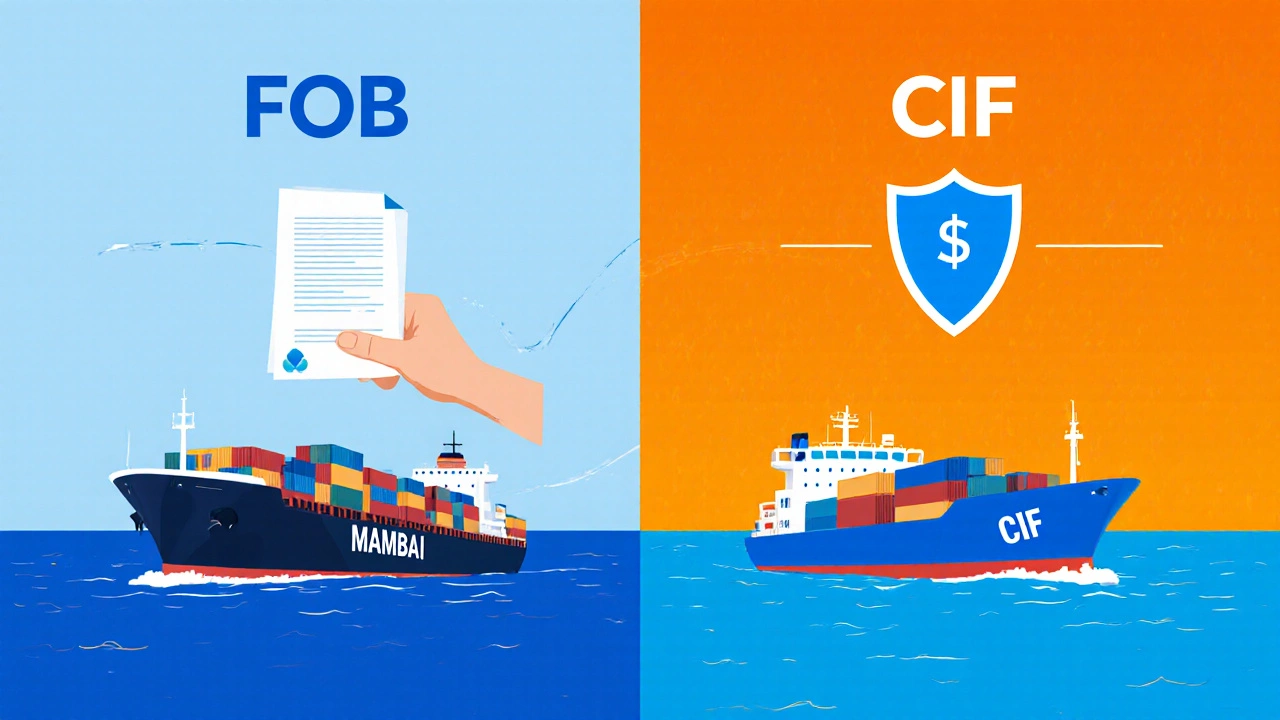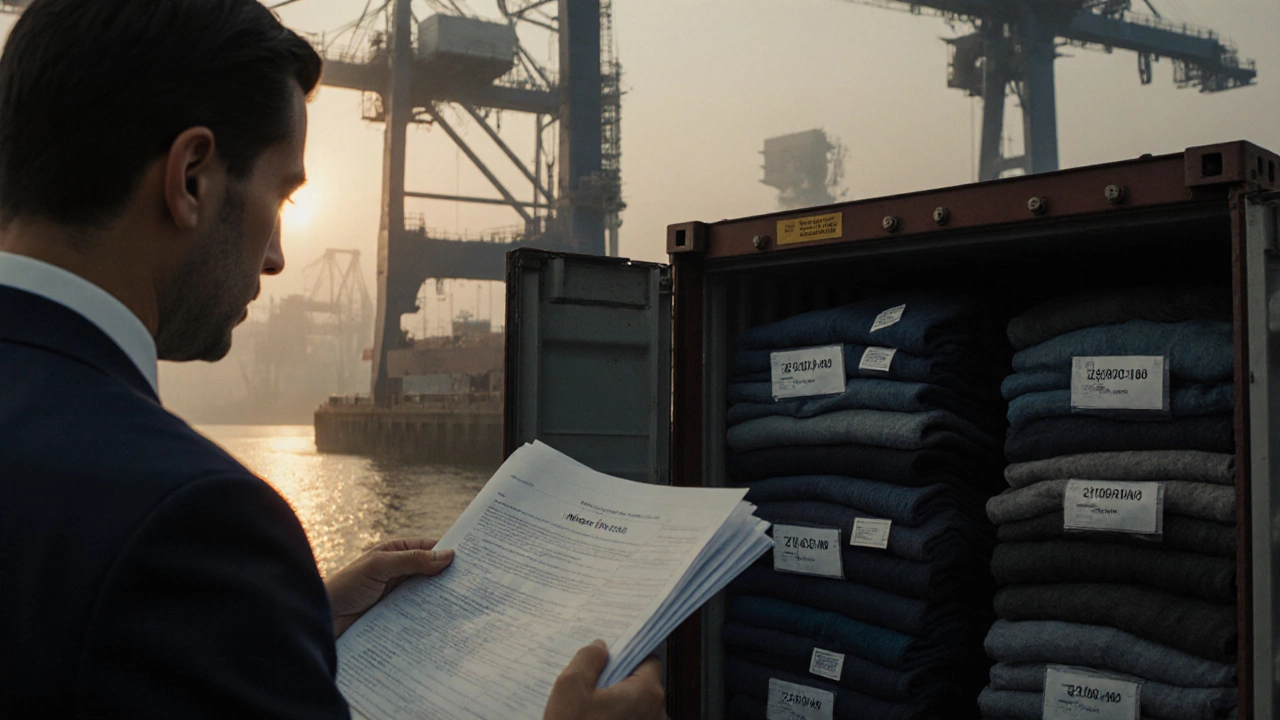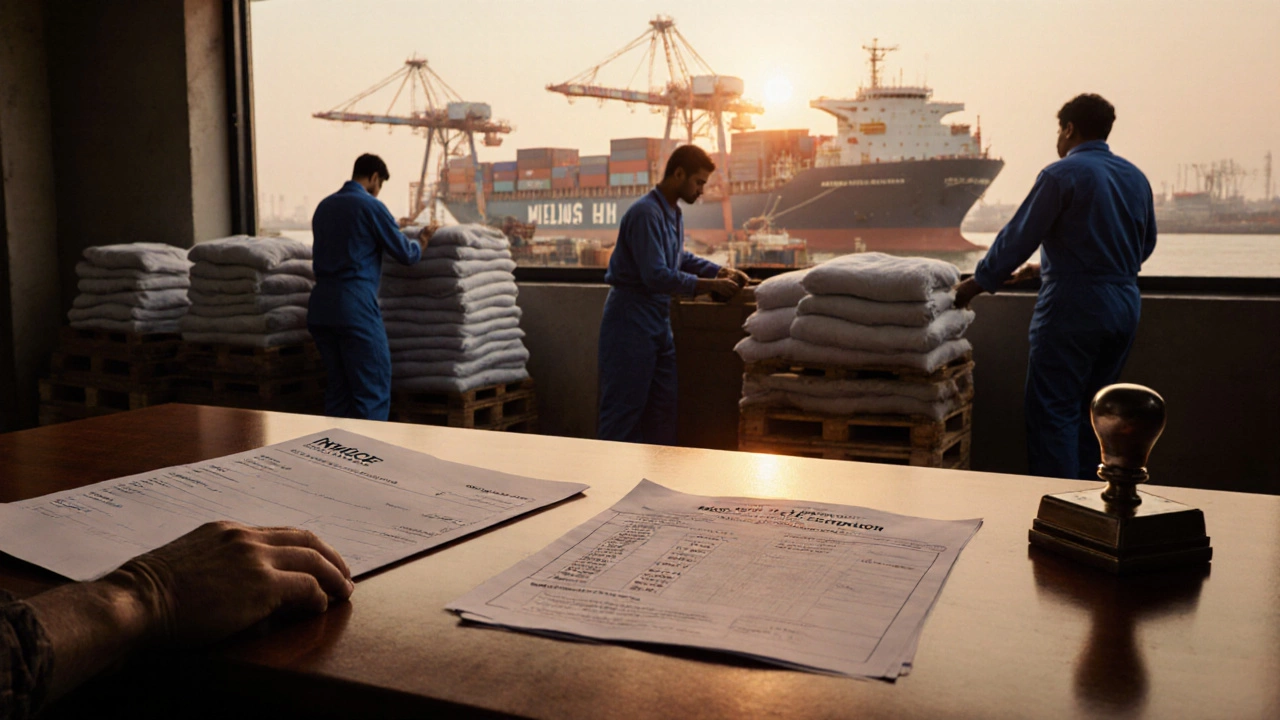Garment Export Cost Calculator
Calculate Your Export Costs
Estimate total landed costs for exporting garments from India to USA. Enter your shipment details to get accurate cost breakdown.
Garment Export is a commercial activity that moves finished clothing items from the producer’s country to an overseas market. For Indian manufacturers eyeing the U.S. market, the journey involves paperwork, compliance checks, logistics choices and payment safeguards. Below is a practical roadmap that walks you through each stage so you can avoid costly delays and get your collection into American stores on time.
Quick Takeaways
- Classify every product with the correct HS Code - most apparel falls under 62 or 61 series.
- Secure a Certificate of Origin and a commercial invoice that matches the HS Code.
- Choose Incoterms wisely: FOB Mumbai is common for sea shipments; CIF is useful when you want the carrier to handle insurance.
- File the Entry Summary (CBP Form 7501) within 15 days of arrival to avoid penalties.
- Use a Letter of Credit or Documentary Collection to protect cash flow.
1. Know the Regulatory Landscape
The United States enforces a strict set of import rules governed by Customs and Border Protection (CBP). Two pillars shape every shipment:
- Classification - Every garment must be assigned a Harmonized System (HS) Code. For example, women’s cotton shirts are 6205.20, while men’s polyester trousers are 6203.42. The HS Code determines duty rates and eligibility for any preferential treatment.
- Origin Rules - The U.S. offers a 0 % duty under the Generalized System of Preferences (GSP) for many Indian textiles, but only if you present a valid Certificate of Origin proving the goods were manufactured in India.
Additionally, keep an eye on any bilateral Free Trade Agreement (FTA) negotiations that could adjust tariff schedules.
2. Gather the Core Documentation
Missing or mismatched paperwork is the top cause of shipment holds at U.S. ports. Here’s the minimal set you need:
- Commercial Invoice - List each product, quantity, unit price, total value, HS Code, and INCOTERMS. Ensure the invoice currency matches your payment terms (usually USD).
- Packing List - Detail how items are packed, weight, dimensions, and container numbers. This helps CBP inspectors verify the cargo.
- Bill of Lading (B/L) or Air Waybill (AWB) - The carrier’s contract of carriage. For sea freight, a clean B/L is essential; for air, the AWB should include the chargeable weight.
- Certificate of Origin - Issued by the Textile Exporters Association of India (TEAI) or a recognized chamber of commerce.
- Import License (if required) - Certain textile items, like those containing wool, may need a USDA or CITES permit.
- NAFTA/USMCA/FTA documentation (if applicable) - Not needed for India‑U.S. trade, but keep it handy if you re‑export to Canada or Mexico later.
3. Choose Incoterms and Shipping Mode
The Incoterm you pick dictates who pays for freight, insurance, and customs clearance. Below is a quick side‑by‑side of the two most common choices for Indian garment exporters.
| Aspect | FOB (Free on Board) | CIF (Cost, Insurance, Freight) |
|---|---|---|
| Who pays freight to U.S. port? | Buyer | Seller |
| Who arranges insurance? | Buyer | Seller (must provide minimum 110 % of cargo value) |
| Customs clearance responsibility | Buyer (through U.S. customs broker) | Seller can pre‑clear, but buyer still files final entry |
| Typical use case | Established buyers with their own logistics network | First‑time buyers or those preferring door‑to‑door service |
For most mid‑size Indian garment companies, FOB Mumbai paired with sea freight is the cost‑effective baseline. If your U.S. partner insists on a turnkey solution, offer CIF with a reputable Shipping Line such as Maersk or MSC.

4. Sea vs. Air Freight - When to Use Which?
- Sea Freight - Ideal for bulk orders (≥20 containers). Transit time from Mumbai to New York is 30‑35 days. Rates in 2025 average $1,500 per 40‑ft container, plus port fees.
- Air Freight - Best for high‑margin, fast‑fashion or sample shipments. A 1 tonne load costs roughly $5,000‑$6,000 from Mumbai to Chicago, with a 3‑5 day door‑to‑door timeline.
Calculate the landed cost per piece for both modes; often the added air premium is justified only when the product margin exceeds 30 %.
5. Clearing U.S. Customs
Once the cargo reaches a U.S. port, a licensed customs broker files the Entry Summary (CBP Form 7501). Key steps:
- Entry Type - Choose “Consumption” for goods entering the U.S. market, or “Temporary Admission” for samples.
- Duty Calculation - Apply the tariff rate associated with your HS Code. For most basic cotton garments, the duty is 12 % of the customs value.
- Marking and Labeling - CBP requires the country of origin label on each item and a care label compliant with the Federal Trade Commission (FTC) rules.
- Inspection - Random examinations are common. Having the original Packing List and B/L ready speeds up the process.
- Payment of Duties - Duties are usually paid by the importer of record (the U.S. buyer) but can be prepaid under a “Delivered Duty Paid (DDP)” arrangement.
Missing any of these steps can trigger a hold, a possible 10 % penalty, or even a seizure.
6. Financing and Payment Protection
Exporting apparel ties up capital. Indian exporters often rely on bank instruments:
- Letter of Credit (LC) - The buyer’s bank guarantees payment once you present compliant shipping documents. Ideal for first‑time buyers.
- Documentary Collection - Less costly than an LC; the seller ships documents to the buyer’s bank, which releases them against payment or acceptance.
- Export Promotion Capital Goods (EPCG) Scheme - Allows duty‑free import of capital equipment for export‑oriented units. Though not a payment tool, it improves cash flow by reducing production costs.
- Export Credit Insurance - Provided by the Export Credit Guarantee Corporation of India (ECGC), covering commercial and political risks up to 90 % of the invoice value.
Choose the instrument that matches your risk tolerance and buyer relationship length.

7. Checklist Before Shipping
- Validate HS Code for every SKU.
- Obtain a certified Certificate of Origin.
- Confirm Incoterm with the buyer and embed it in the commercial invoice.
- Secure a reliable customs broker in the destination port.
- Arrange freight insurance covering at least 110 % of cargo value.
- Set up the payment instrument (LC, Documentary Collection, etc.).
- Prepare a compliance folder: invoices, packing list, B/L, CO, and any special permits.
- Schedule a pre‑departure inspection with your QA team.
8. Common Pitfalls & Pro Tips
Pitfall: Using an outdated HS Code. Tip: Check the latest Customs Tariff schedule every quarter.
Pitfall: Forgetting the “Made in India” label on each garment. Tip: Include label instructions in the production SOP.
Pitfall: Relying on a single freight forwarder for both sea and air. Tip: Build relationships with at least two carriers to negotiate better rates and avoid capacity bottlenecks during peak seasons.
Pitfall: Not factoring in the U.S. seasonal sales calendar. Tip: Align shipments with the Spring/Summer launch (January‑March) and Fall/Winter launch (July‑September) to meet retailer buying windows.
Frequently Asked Questions
Do I need a special license to export cotton garments?
No separate export license is required for plain cotton apparel. However, if the fabric contains cotton blended with a controlled material (e.g., wool, silk), you may need a CITES or USDA permit.
How long does customs clearance usually take?
If all documents are in order, CBP clears most apparel shipments within 24‑48 hours of arrival. Random inspections can extend this to 5‑7 days.
Can I claim the GSP duty exemption?
Yes, provided you present a valid Certificate of Origin and the product qualifies under the GSP list. The exemption is 0 % duty for most woven and knit apparel.
What’s the best Incoterm for a new U.S. buyer?
CIF is often preferred for first‑time buyers because it bundles freight and insurance, reducing their upfront logistics burden.
Should I use sea freight for a $5,000 order?
Usually not. The cost of a 20‑ft container ($1,500) plus handling can exceed the order value. Air freight or a consolidated LCL (Less‑than‑Container Load) service is more economical for low‑value shipments.
Exporting garments from India to the United States is entirely doable once you master the paperwork, pick the right logistics model, and protect your cash flow. Follow the steps above, keep an eye on regulatory updates, and you’ll turn the trans‑Pacific trade route into a steady revenue stream.
